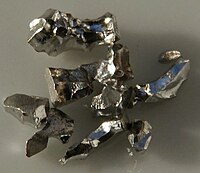
Photo from wikipedia
Abstract In this work, iridium complexes 1–8 bearing bipyridine or pyridine-pyrimidine main ligand and picolinate ancillary ligand have been designed by varying the position of –OCH3 and phenyl groups at… Click to show full abstract
Abstract In this work, iridium complexes 1–8 bearing bipyridine or pyridine-pyrimidine main ligand and picolinate ancillary ligand have been designed by varying the position of –OCH3 and phenyl groups at the ligands aiming at finding a better choice to design blue phosphors. The results indicate that an appropriate combination of –OCH3 and pyridine-pyrimidine ligand makes the emission wavelength a noticeable blue-shift. Moreover, the further introduction of phenyl group shifts the emission wavelength to a shorter region. In terms of the radiative decay rate constant (kr), the position of –OCH3 has a slight influence on it, but the introduction of phenyl group is conductive to enhancing this value. In particular, the 7 has the largest kr among the designed complexes up to 7.68 × 105 s−1. As for the non-radiative process, 1–6 have high barriers between 3MLCT and 3MC, indicating the difficulty of electron relaxation to the non-emissive 3MC structure. There is no transition state of 3MLCT↔3MC is found for 7 and 8 bearing pyridine-pyrimidine ligand. However, the barriers of all complexes for the S0/3MC minimum energy crossing point reaction are high, which is in favor of avoiding the system relaxes to the S0 geometry by non-radiative path.
Journal Title: Journal of Luminescence
Year Published: 2019
Link to full text (if available)
Share on Social Media: Sign Up to like & get
recommendations!